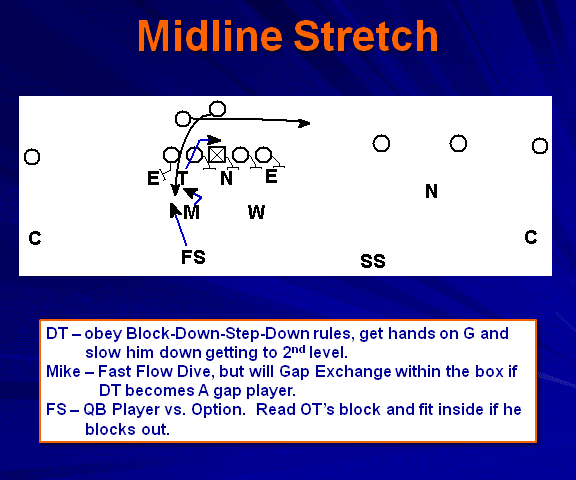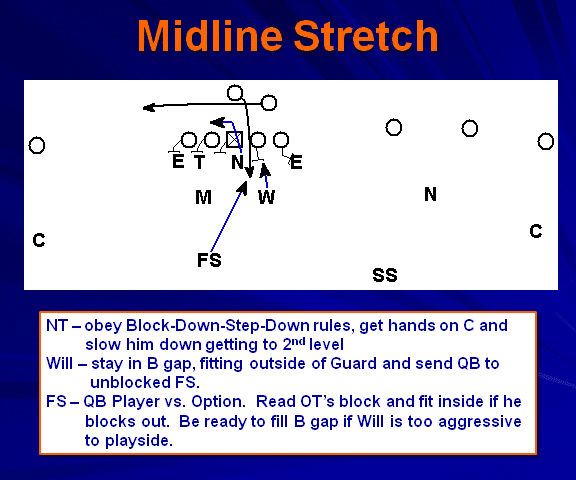Introduction
Bash and Midline are two plays in the Oregon Spread offense that are giving a lot of Defensive Coordinators headaches. Both plays have recently burst onto the scene, but they both have actually been around for some time. I saw Texas A & M run a form of Bash in their 2006 bowl game (Editors note: I found out in 2019 that it actually was Bash) and North Alabama ran the Midline from Gun as far back as 2003. I will talk about Bash and Midline, but I will talk about defending Midline only.
Bash
Let me apologize beforehand to all the defensive coaches reading this that my knowledge of this play is primarily from an offensive standpoint. The word Bash stands for Backside Sweep and it is a tag that the University of Florida used in their run game during the Urban Meyer era. The first team I saw running this type of concept was Texas A & M (actually the play I saw them run was Flash, which is a tag that stands for Frontside Sweep) (Editors note: again, this was Bash that they ran) . Bash is also a play tag concept used successfully by the Oregon offense, although they may call it something else.
Meyer got a lot of mileage out of the Zone Read play at Utah, which had a big Fullback-type at RB, hitting the defense between the tackles and Alex Smith, a thin and athletic-enough QB to pull the ball and hurt the defense on the perimeter when the DE crashed. Meyer did not have much success duplicating the same formula at Florida and was undoubtedly frustrated by not being able to recruit the big RB to make the Zone Read play work to its fullest potential.
However, in his quest to assemble "the fastest team in college football," he found himself with an abundance of smaller skill guys who were extremely dangerous with the ball in their hands—Percy Harvin, Jeff Demps, and Chris Rainey. These guys were capable of playing RB, but they were not capable of withstanding the pounding of running between the tackles for an entire year. Meyer and OC Dan Mullin had a Fullback-type, but he happened to be their QB, so they installed Bash and had the QB and RB switch roles to take advantage of their talents: Tim Tebow running it up the gut and Percy Harvin/Jeff Demps/Chris Rainey using their speed on the perimeter.
Oregon runs Bash a bit differently than Florida did. Florida had their Bash guy line up in the backfield and he left on the snap of the ball. Oregon likes to start their Bash guy at WR and put him in Jet motion. The motion is harder to time up, but it really gives the Bash sweeper a full head of steam. This stresses the defense by forcing the DE to make an even quicker decision on the play. The RB in the backfield would then be a lead blocker for the Bash sweeper and he would block the Force player.
Here are some examples of Bash, which is simply a tag put at the end of any QB run:
Meyer got a lot of mileage out of the Zone Read play at Utah, which had a big Fullback-type at RB, hitting the defense between the tackles and Alex Smith, a thin and athletic-enough QB to pull the ball and hurt the defense on the perimeter when the DE crashed. Meyer did not have much success duplicating the same formula at Florida and was undoubtedly frustrated by not being able to recruit the big RB to make the Zone Read play work to its fullest potential.
However, in his quest to assemble "the fastest team in college football," he found himself with an abundance of smaller skill guys who were extremely dangerous with the ball in their hands—Percy Harvin, Jeff Demps, and Chris Rainey. These guys were capable of playing RB, but they were not capable of withstanding the pounding of running between the tackles for an entire year. Meyer and OC Dan Mullin had a Fullback-type, but he happened to be their QB, so they installed Bash and had the QB and RB switch roles to take advantage of their talents: Tim Tebow running it up the gut and Percy Harvin/Jeff Demps/Chris Rainey using their speed on the perimeter.
Oregon runs Bash a bit differently than Florida did. Florida had their Bash guy line up in the backfield and he left on the snap of the ball. Oregon likes to start their Bash guy at WR and put him in Jet motion. The motion is harder to time up, but it really gives the Bash sweeper a full head of steam. This stresses the defense by forcing the DE to make an even quicker decision on the play. The RB in the backfield would then be a lead blocker for the Bash sweeper and he would block the Force player.
Here are some examples of Bash, which is simply a tag put at the end of any QB run:
As far as defending Bash, the key is your perimeter run defense. Oregon and Florida do a good job of running this play with the RB as a lead blocker. The teams that do not have a lead blocker are at a disadvantage if the defense has a player in the Alley without anyone to block him. The defense can have the DE take the QB and the Bash sweeper will have no one to block the Alley player for him.
Midline
The Midline play is tough on Defensive Coordinators because instead of the offense reading the DE, they read the DT. The Defensive Tackle is not as good of an athlete and teams like Oregon have made a good living with their athletic QB vs. a slower DT trying to make a tackle in space. This is definitely a mismatch and the QB is too often able to make a quick move and run through a hole big enough to drive a truck through.
Instead of having the DT trying to make a play in space, it makes sense to have the LB and FS take care of the QB, as I learned from Coach Currier on the Huey site. This lets your DT obey his Block-Down-Step-Down rule and stay consistent with everything he has been taught. What the DT cannot do is to come straight upfield (see the USC DT in the cut-ups). The 4-3 DT should never come straight upfield for any reason.
The FS still has the QB vs. the Option, so his job does not change vs. Midline. I said in the previous article on LB play that the LB does not have to worry about Gap Exchange with the DE vs. Zone Read. That's because he would have to scrape outside the box, and I want him to be a box player vs. the run so he can be more aggressive.
The FS still has the QB vs. the Option, so his job does not change vs. Midline. I said in the previous article on LB play that the LB does not have to worry about Gap Exchange with the DE vs. Zone Read. That's because he would have to scrape outside the box, and I want him to be a box player vs. the run so he can be more aggressive.
If the 3 technique DT is to the RB side and he obeys his Block-Down-Step-Down (rule first diagram below), he will become the A gap player. The Mike LB will start out as an A gap player, but once he sees the DT close down into the A gap, he will Gap Exchange and become the B gap player. His Gap Exchange will occur within the box. I would not ask him to Gap Exchange and scrape outside the box, because that's what the FS is for in this Quarters coverage. The FS must read the OT's block on the DE and fill inside to get to the QB.
The second diagram has the RB flipped to the other side. Now there will be no Gap Exchange with the NT. The Will LB must maintain his B gap, but the FS can help him out and become the B gap player if Will is too aggressive and takes the A gap.
Oregon loves this play in the Red Zone. It is a much more successful option for them than Stretch when they are out-numbered in the box (see for yourself the Goal-Line / Short-Yardage cut-ups in the second video). It could be helpful to have the DT that is aligned to the RB side to tighten his alignment on the Guard to almost a 2 technique to help keep the Guard from getting to the 2nd level, much like having a 5 technique DE tighten his alignment to help vs. Inside Veer. Of course, Oregon could flip their RB to combat this, too. It is definitely a chess match that I am looking forward to watching Monday night to see how Auburn DC Gene Chizik will try to defend Bash and Midline.
Oregon loves this play in the Red Zone. It is a much more successful option for them than Stretch when they are out-numbered in the box (see for yourself the Goal-Line / Short-Yardage cut-ups in the second video). It could be helpful to have the DT that is aligned to the RB side to tighten his alignment on the Guard to almost a 2 technique to help keep the Guard from getting to the 2nd level, much like having a 5 technique DE tighten his alignment to help vs. Inside Veer. Of course, Oregon could flip their RB to combat this, too. It is definitely a chess match that I am looking forward to watching Monday night to see how Auburn DC Gene Chizik will try to defend Bash and Midline.
Defending Bash and Midline
1. vs. Bash
2. DT vs. Gun Midline
3. DT/LB Mistakes vs. Gun Midline
Goal-Line and Short-Yardage cut-ups:
Goal Line / Short-Yardage Defense vs. Oregon Spread from Barry Hoover on Vimeo.
Goal-Line / Short-Yardage vs. Oregon Spread
1. Goal-Line
2. GL - vs. Pass
3. GL - Slanting the DL
4. GL - Bad LB Play
5. Short-Yardage
4-3 vs. the Oregon Spread - schedule of posts
Jan 1 - DL Play
After the National Championship game, I will have an outstanding series of articles and videos with some terrific guest writers.
A very good article on Run COD Hit's blog here that talks about the same concepts.
A nice look at the Auburn run game here: http://offensivebreakdown.blogspot.com/2011/01/auburn-run-game-inverted-veer.html
4. GL - Bad LB Play
5. Short-Yardage
4-3 vs. the Oregon Spread - schedule of posts
Jan 1 - DL Play
Jan 3 - Zone Blitzes
Jan 5 - LB Play
Jan 7 - Defending Bash and Midline
Jan 9 - DB Play and Coverage Fundamentals
Jan 10 - (National Championship Game - Oregon vs. Auburn - 8:30 pm)
A very good article on Run COD Hit's blog here that talks about the same concepts.
A nice look at the Auburn run game here: http://offensivebreakdown.blogspot.com/2011/01/auburn-run-game-inverted-veer.html








What is your coverage call? Corners play flat with two deep? Lb to trips plays the hash?
ReplyDeleteQuarters or Palms with the SS and Corner. LB to Trips would be a short wall of 3 player and the WS would be the long wall of 3 vertical.
ReplyDeleteThe summary of points to defending bash? Fronts, Line movements,pressures,Coverages?
ReplyDeleteMake sure your perimeter defense is sound and figure out who you want to have the football--the Back or QB.
ReplyDelete